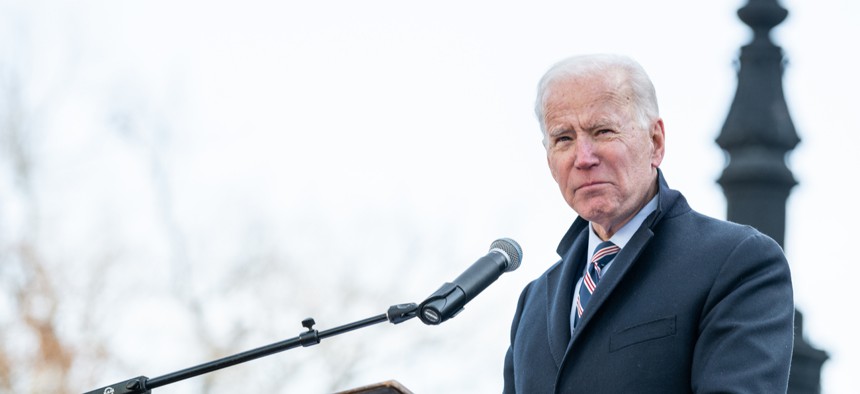
Then-candidate Joe Biden on the campaign trail in South Carolina in January 2020. Crush Rush/Shutterstock.com
Biden Needs a Strategy for Strengthening the Federal Workforce
Mending the public service isn’t just one more thing to do—it’s the way to do everything that needs to be done.
There’s precious little oxygen in the room to feed solutions to all the policy problems that Joe Biden faces. But one thing is certain: There’s no solution to any of the problems without quickly putting together a strategy for strengthening the federal workforce. Addressing the public service isn’t just one more thing to do. It’s the way to do everything that has to get done.
That’s the overwhelming consensus that emerged from a forum among the fellows of the National Academy of Public Administration held on Friday, January 15.
In the weeks and months to come, Job One is putting the country’s faith in government back on an even keel—and getting vaccines into everyone’s arms. There are two important truths here. First, an important way of solving the first problem is to crack the second. How—and how well—the president deals with the vaccination program will tell citizens a lot about how he will approach the job and how much they will trust him to do it.
Second: the vaccination effort, at its core, is a people problem. So far, we haven’t done a good job of connecting federal agencies to the state and local officials who will be running vaccination centers. And we don’t have enough first-line vaccinators to get the job done at the pace we’ll need. It’s a people problem. And it’s a microcosm of so many of the other issues facing the federal government. If President Biden wants to succeed, he’ll need to make people-based solutions the core of everything he wants to do.
The NAPA discussion had consensus on four big action items to make this happen.
First, it’s essential that President Biden himself signal to federal workers the importance of the role they play in making government work. This doesn’t need to be fancy, and it shouldn’t get hung up in a lengthy clearance process of new initiatives. But it could begin by striking down the series of recent executive orders—especially those creating the new Schedule F and purging diversity training programs. And it could also happen through a presidential proclamation stating, unequivocally, his support for federal workers and the work they do. A short Zoom meeting with the federal government’s Senior Executive Service leaders would be invaluable to rebuilding the trust of SES members.
Second, the new administration needs to work from the bottom up to get its work done. In the last 20 years, we’ve had a series of top-down, Cabinet-secretary-based initiatives to drive government reform. In the Bush and Obama administrations, we’ve made real progress, but we’ve gone about as far as we can go this way. We need action at lower levels—agencies like the National Park Service, IRS, Federal Aviation Administration, FEMA, and the host of agencies that do the government’s work and with which employees most identify. These are the change agents in the federal government, and connecting federal employees with agency leaders is the most important step in turning the ship around.
Third, bureau and agency leaders should focus on performance to build trust. Citizens don’t have much trust for government at the wholesale level—for major institutions like Congress and for government writ large. But there’s strong and growing evidence that they trust most of the programs with which they interact a great deal and which treat them well. Federal officials—not even the president—can do much in the short run to solve the mega-crisis of distrust in American government. Bureau heads and other agency leaders below the Cabinet level, however, can do a lot to change their connections with citizens.
We have a vast and rising reservoir of data that tells us how to do this well. The Office of Management and Budget, for example, has looked carefully at the connection between citizen satisfaction about government programs managed by the Veterans Affairs Department and the Transportation Security Administration. It turns out that satisfaction is closely connected with employee engagement, and that more-engaged employees produce happier citizens. There’s emerging evidence that bureau chiefs can significantly move the needle on both fronts. One federal initiative has focused on trying to improve employee engagement in the agencies ranking in the bottom 20%. One senior manager said, “Somebody has to be in the bottom fifth—but it’s not going to be us anymore.”
Data-driven initiatives to improve employee engagement, and through engaged employees to improve the citizens’ experience, is proven to improve trust, at least at the retail level. It’s clear, it’s actionable, it’s effective—and it works. It’s a strategy that every bureau chief can begin on Day One, and it’s a strategy that every cabinet secretary can support as Job One.
Fourth, we need more people with the right skills in the right places to accomplish Job One. The struggle to launch the immunization campaign has made that painfully clear. The problem spills over to a host of other agencies. Cutbacks in IRS staffing is putting at risk our system of (mostly) voluntary tax collection, and it’s draining billions of dollars from the U.S. Treasury. We can look across the federal government to find similar problems that are growing into crises.
We simply don’t have a good handle on the gap between the government capacity we’ve got and the people we’ll need. Agency heads need not only a “damage assessment plan,” as one NAPA panel participant suggested, to determine where we are and where the gaps are. They also need a clear sense of where they need to be in four years—and how they’re going to get there. Any strategic plan needs a strategy.
And the first three elements of that strategy are hiring, hiring and hiring. There’s evidence that skilled people want to work for the federal government. We need to round up as much authority as we’ve already got—and create new authority through legislation if necessary—to figure out the people we need and to hire them fast. From start to finish, we need a target of bringing new feds on board in less than 90 days. New hiring authority to recruit feds for five-year tours in the government would be a huge boost—and it would recognize the changing dynamics of workplaces everywhere.
This is as complex and difficult a transition as any president has faced at least since Franklin D. Roosevelt in 1933. With the maelstrom of issues swirling around Joe Biden, it’s going to be tough for anyone to seize on anything. But it’s the inescapable truth that he won’t be able to get anything done unless the new administration tackles these public service issues. As NAPA’s previous work has pointed out, there’s no time to wait.







